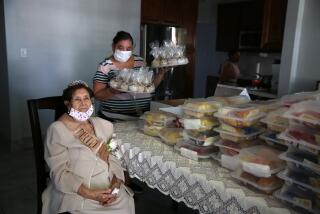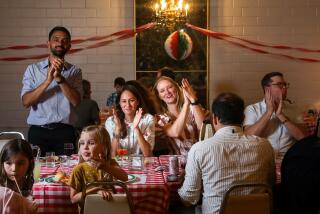Susan Alsop, 86; Her Galas Were Forum for Ruling Elite
- Share via
Susan Mary Alsop, the grand dame of Washington society whose Georgetown dinner parties epitomized the nexus of political power and social arrival in the 1960s, died Wednesday of complications from pneumonia at her home. She was 86.
Alsop’s dining room was considered the absolute center of Georgetown’s social scene at a time when President John F. Kennedy’s arrival energized the once-sleepy capital. Her guests were the witty, the accomplished and the credentialed from the worlds of politics, media and diplomacy, and they used the opportunity to strike alliances, argue foreign affairs and bargain over the nation’s fortunes.
As the descendant of one of America’s first families (she was a Jay, as in John Jay, the first chief justice of the United States), she grew up privileged and firmly a member of the most elite Eastern establishment circles. She dined with presidents and prime ministers, often at her home, and frequently at the salons of the rich and powerful, where the conversations often were continuations of parliamentary or embassy debates.
“All these stories will be in the history books,” she wrote to a friend in a letter, “but it does send a chill down one’s spine to hear them told by the actors in the drama.”
As a young woman, she had Sunday night suppers with Franklin and Eleanor Roosevelt in the White House. The president, armed with a martini shaker, would urge guests to dip into a bowl of Russian caviar. “They called it Uncle Joe’s bounty. The idea was to eat as much of that as possible,” she said in one of her books.
As a teenager, she had tea with Edith Wharton and was disappointed that the great writer was “a gossipy old girl,” she told a visitor 11 years ago. As the young wife of an embassy official in Paris, she was often seated beside British Prime Minister Winston Churchill (“He has decided I am ... French ... and nothing will deter him from speaking French to me”) when she wasn’t drinking champagne with Noel Coward and the Duke of Windsor.
In Washington, widowed and remarried to newspaper columnist Joe Alsop, she always had her hair done in case she was invited for dinner at the Kennedy White House. Hers was the only private home that Kennedy visited on his inauguration night, stopping in for a bowl of terrapin soup.
“Susan Mary loved to connect people together, young and old. Some were famous, some were not,” said her daughter, Anne Milliken. “All that mattered to her inquisitive mind was that her guests be engaged in living life.”
Susan Mary Jay was born in Rome, the daughter of a diplomat, and grew up in South America and Europe. Her mother attended the wedding of Russia’s Nicholas and Alexandra in 1894. She attended Foxcroft, a boarding school, in Middleburg, Va., and took courses at Barnard College. When her mother offered the 18-year-old either a debutante ball or a trip abroad, the young woman immediately chose the trip.
She began working at Vogue magazine in 1939 as a receptionist, writer and model. After World War II, she joined her husband, Bill Patten, in Paris, where he worked for the embassy. She immediately put them on the diplomatic social circuit, where she was described as “stylish, intelligent, loving and good, and very funny.” Christian Dior and other French designers let her wear their latest ball gowns for a pittance, which was necessary because she did not have the great wealth that others in her circle assumed.
In Paris, she began giving the parties for which she later became so well-known. Her letters, collected in the book “To Marietta From Paris: 1945-1960” (1975), are dizzy with names: Greta Garbo, Ho Chi Minh, the Rothschilds.
Patten died in 1960, after years of battling emphysema. She married his college roommate, columnist Joseph Alsop, the next year, and moved to Washington, apparently with full knowledge that he was gay.
She said he was a good stepfather to her daughter and son, Bill Patten, although memoirs from the period say he treated her rudely in public.
The couple divorced in 1973 but remained friends, and continued to give dinners together. He died in 1989.
Alsop began her literary career after the divorce. She first edited her letters, followed by “Lady Sackville: A Biography” (1978), “Yankees at the Court: The First Americans in Paris” (1982) and “The Congress Dances: Vienna 1814-1815” (1984). She became a contributing editor to Architectural Digest.
Her survivors, in addition to her son, of Worcester, Mass., and her daughter, of Salt Lake City, include seven grandchildren and a great-grandson.
More to Read
Sign up for Essential California
The most important California stories and recommendations in your inbox every morning.
You may occasionally receive promotional content from the Los Angeles Times.













